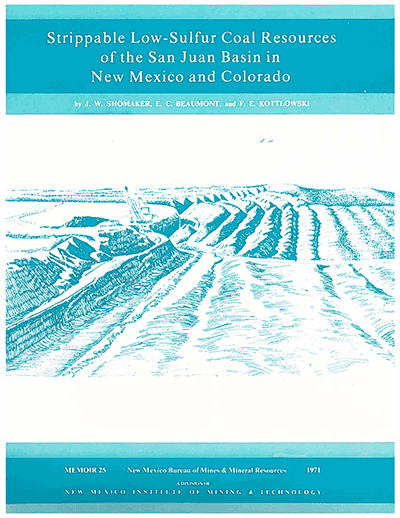
Memoir 25—Strippable low-sulfur coal resources of the San Juan Basin in New Mexico and Colorado

Compiled and edited by J. W. Shomaker, E. C. Beaumont, and F. E. Kottlowski, 1971, reprinted 1976, 189 pp., 57 tables, 59 figs., 4 plates, 1 appendix, 1 index.
A study describing the amount, location, quality, and economic position of low-sulfur strippable coal in the San Juan Basin, northwest New Mexico and southwest Colorado. Study conducted by the New Mexico Bureau of Mines and Mineral Resources for the Air Pollution Control Office of the Environmental Protection Agency.
Articles included in this memoir are:
- Stratigraphic distribution of coal in San Juan Basin — E. C. Beaumont
- Cortez Dakota area — J. W. Shomaker
- Gallup Mesaverde field — R. C. Lease and J. W. Shomaker
- Hogback Upper Menefee area — R. C. Lease
- Toadlena Upper Meneffe area — R. C. Lease
- Newcomb Upper Menefee area — J. W. Shomaker
- Chaco Canyon Upper Menefee area — R. C. Lease
- Chacra Mesa Menefee area — W. R. Speer
- San Mateo Menefee area — W. H. Pierce and J. W. Shomaker
- Standing Rock Cleary area — J. W. Shomaker
- Zuni Mesaverde area — F. E. Kottlowski
- Crownpoint Crevasse Canyon area — J. W. Shomaker
- South Mount Taylor Crevasse Canyon area — F. E. Kottlowski and T. A. Parkhill
- East Mount Taylor Crevasse Canyon area — F. E. Kottlowski, E. C. Beaumont, and T. A. Parkhill
- Rio Puerco Mesaverde area — J. W. Shomaker
- La Ventana Mesaverde field — J. W. Shomaker
- Tierra Amarilla Mesaverde field — E. C. Beaumont
- Monero Mesaverde field — J. W. Shomaker
- Pagosa Springs Cretaceous area by J. W. Shomaker
- Durango Fruitland area — R. C. Lease, Red Mesa Fruitland area — W. R. Speer
- Fruitland field — E. C. Beaumont
- Navajo Fruitland field — J. W. Shomaker
- Bisti Fruitland area — J. W. Shomaker
- Star Lake Fruitland area — J. W. Shomaker and R. C. Lease
- Drilling and wash-ability testing — J. W. Shomaker and R. C. Lease
- Economic factors in the utilization of San Juan Basin coal — W. R. Speer
- Sulfur in San Juan Basin coals — F. E. Kottlowski and E. C. Beaumont
The report is a compendium of short, more or less self-contained papers dealing with the various coal fields and areas, and with other pertinent subjects. For the purposes of study, coal reserves were estimated in two broad categories-those consisting of beds three feet thick or thicker beneath 10–150 ft of overburden, and those in beds five or more feet thick beneath 150–250 ft of overburden. Data were gathered from all available sources and include: published geologic work, original geologic observation, private consultants' reports, logs of test holes drilled by holders of leases and exploration permits, logs of holes drilled by the New Mexico Bureau of Mines and Mineral Resources, reserve calculations furnished by operators, and information from oil and gas tests. The best use was made of whatever data could be found for a particular area; therefore reserve estimates range in reliability from proven tonnages to speculation based on geologic inferences. An effort was made to give an evaluation of the reliability of each estimate. Coal quality was determined from published and unpublished analyses by the U.S. Bureau of Mines, analyses furnished by operators, and U.S. Bureau of Mines analyses of samples collected during the study.
The San Juan Basin is a major physiographic subdivision of the Colorado Plateau in northwestern New Mexico and southwestern Colorado. The basin is about 200 mi long (north to south) and 130 mi wide, and includes about 26,000 mi2. The strippable coal areas lie along the basin's margins-mainly the western and southern-in roughly concentric belts of outcrop of coal-bearing strata of generally Cretaceous age, with rolling, sparsely grassed plains interrupted by low cuestas and mesas, and broad sandy washes. Coal is found in three major zones of the Cretaceous sequence. In ascending order, they are: the Dakota Sandstone, the Mesaverde Group, and the Fruitland Formation; the three are separated by barren strata of greatly varying thickness.
$13.50
Buy
Now
Also available as a free download.
Download
| File Name | Size | Last Modified |
|---|---|---|
| Memoir-25.pdf | 57.73 MB | 01/19/2021 09:25:57 AM |
| Memoir-25.zip | 60.76 MB | 01/19/2021 09:26:23 AM |
| Plates: | ||
| Memoir-25_Plates.pdf | 3.74 MB | 01/19/2021 09:26:13 AM |



